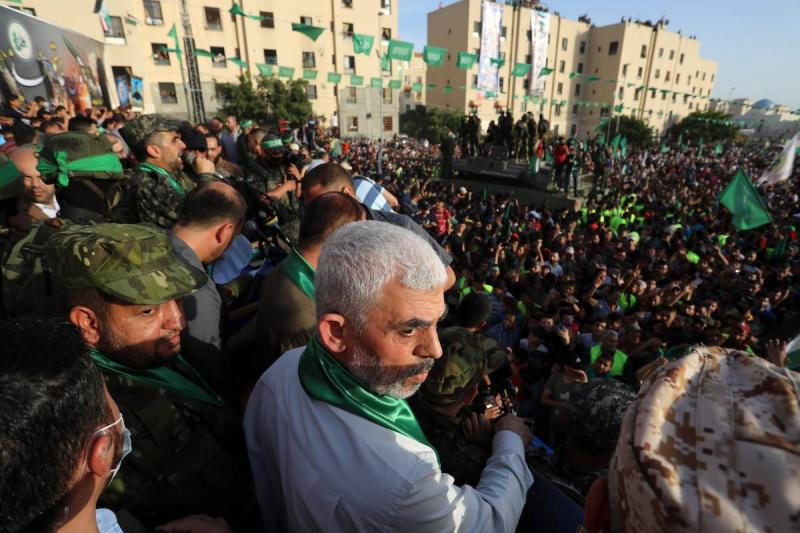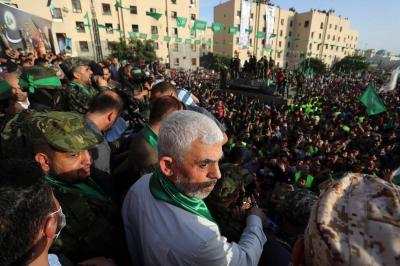The ongoing Israeli war on the Gaza Strip, lasting over three months, has forced the leadership of Hamas, which is facing persecution, to adopt stricter security measures in their communication processes. This applies both within the political leadership in Gaza and with the military wing, al-Qassam Brigades, as well as with the movement's leadership abroad. Hamas officials need to communicate with each other intensively to consult and make decisions related to the war, ceasefire proposals, and exchange deals.
The leadership in Gaza decides the fate of any proposal or deal, which necessitates continuous discussions, albeit in a secretive manner to prevent any leaks of internal information. To ensure this, the Hamas leadership utilizes a secret communication system, which began with a special landline system and has evolved into a primitive method of contact using written messages. Sources close to Hamas leadership disclosed that the movement's leaders rely on a particular mechanism for communication among themselves, especially with leaders abroad, due to the nearly permanent disruption of communications and the internet in the Gaza Strip, as well as to avoid Israeli tracking.
The sources explained that in the beginning of the Israeli war, the leaders of Hamas and al-Qassam relied on the movement’s special landline communications, which engineers from Hamas's military wing invented in 2009 and have been continually developing, utilizing technology allegedly smuggled from outside the enclave, likely through tunnels along the border with Egypt.
Moreover, the sources noted that al-Qassam Brigades installed underground exchanges connected to very old landlines at specific points above ground, which were regularly tested to prevent infiltration and underwent monthly maintenance. Each leader at various levels, whether political or military, had a specific contact point with a designated number for emergency communications.
Sources mentioned that Israel was aware of this system and attempted to infiltrate it multiple times, as well as tried to target it. They stated, "In a secret war, the enemy succeeded in May 2018 in blowing up a telephone exchange after it was bombed west of Al-Zawayda in central Gaza, which led to the assassination of a group of al-Qassam engineers who were trying to uncover a security breach at that point, causing the exchange to explode."
Furthermore, before and after that date, the enemy attempted several times to breach this system, indicating that a special Israeli force infiltrated Gaza and carried out a series of missions, including an attempt to infiltrate Hamas's communication system before being discovered in November 2018 during a mission east of Khan Younis, leading to their extraction under fire after two of their members were killed.
It appears that Hamas maintained the structure of these communications at the beginning of the current Israeli war on Gaza, even though the Israeli army focused on targeting some communication points, destroying some of them, and demolishing tunnels that contained key communication exchanges.
The sources confirmed that despite the damage to the communication network, the movement's leadership continued managing its communications via these exchanges, including the intensive communications that determined the humanitarian truce that lasted for seven days. They clarified that the engineers of al-Qassam managed to restore some of these exchanges to operation and activated new contact points.
The sources revealed to Asharq Al-Awsat that the ceasefire negotiations were conducted internally and then someone was tasked with relaying the answers to the leadership abroad. They stated, "The ceasefire negotiations that led to the release of dozens of Palestinian and Israeli prisoners were conducted through internal communication between some Hamas and al-Qassam leaders via landlines, and then a person was tasked with conveying the agreements to the movement's leadership abroad using various methods, including the internet via electronic chips and encrypted programs purchased by the movement from abroad."
They added, "Sometimes, calls were made to individuals unrelated to the movement but closely connected to it, residing in various capitals, who in turn relayed those messages to the leadership in Doha and Beirut."
Hamas utilized its private internal communications to interact with the Islamic Jihad Movement, having previously equipped them with some contact points for necessary communication. This likely explains how the delivery of prisoners and detainees during the last ceasefire coincided with the joint emergence of al-Qassam and Saraya al-Quds (the armed wing of Islamic Jihad).
After hostilities resumed following the failure to extend the humanitarian ceasefire, Israel aggressively targeted Hamas positions, and as attacks, including ground incursions, expanded to broader targets in the central and southern Gaza Strip, the movement lost many of its tunnels designated for communication exchanges, along with numerous specific contact points above ground.
The sources confirmed that this prompted the leaderships of Hamas and al-Qassam in Gaza to revert to very old communication methods to manage negotiations and other organizational issues amidst the ongoing conflict. They explained that Hamas resorted to some members or close associates who are not publicly known to convey handwritten messages from one person to another and from one location to another. They added, "This is carried out under strict security procedures to prevent any tracking of communication movements under any circumstances."
These handwritten messages are delivered to individuals who also maintain different means of communication with the movement's leadership abroad. The leadership abroad needs the approval of the leadership in Gaza for any decisions concerning the war.
The sources confirmed that the leaders of Hamas and al-Qassam in Gaza are the ones finalizing any agreements, indicating that the movement's leadership abroad does not make any decision without the consent of leadership in the enclave, particularly its head, Yahya Sinwar. The communication operations among Hamas leaders provoke considerable debate within the Israeli security establishment, which has so far been unsuccessful in reaching Sinwar or top-tier al-Qassam leaders such as Mohammed Deif, Marwan Issa, or Mohammed Sinwar, Yahya's brother.




